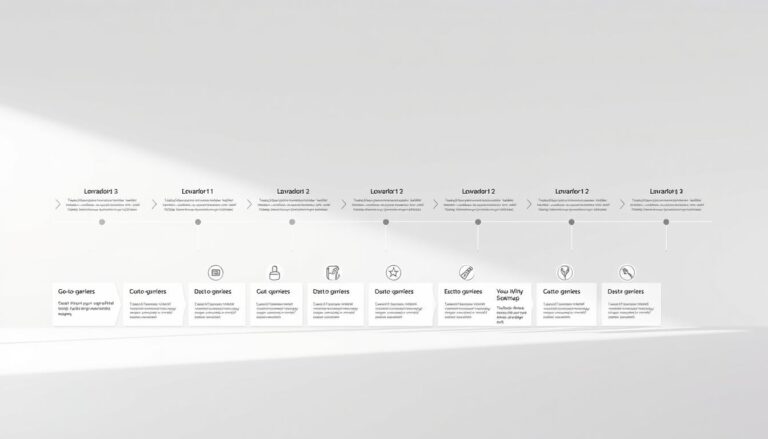In the corporate world, digital transformation strategies are crucial. They differentiate leaders from followers. Achieving top efficiency with technology is essential, not just a goal. Companies around the globe are focusing on enhancing efficiency through technology. This effort helps them grow, become more scalable, and sustainable. At the heart of this goal lies tech-driven business optimization. It’s vital for firms that want to stand out in a fast-paced, innovative market.
Technology has transformed operations from factories to offices. For example, in the UK, office workers are productive for less than three hours a day. This fact underscores the need for better practices. Microsoft has found that over 40% of workers are thinking about quitting their jobs. To keep these employees, businesses must focus on becoming more efficient. This will not only keep staff but also boost their productivity.
When companies focus on becoming more efficient, they don’t just save money. They also improve their products or services, make things faster, and get to market quicker. The benefits are significant. Customers are happier, companies become more resilient, and they’re sharper. This sharpness helps them grab new opportunities as they come up.
Key Takeaways
- Cost Efficiency: Operational efficiency is key to spending less by using resources better.
- Revenue and Profitability: Being more efficient means higher profits by wasting less and offering better quality.
- Market Responsiveness: Quick product launches and speedy project deliveries are vital for staying competitive.
- Customer Satisfaction: Better operations lead to better products and services, which makes customers happy.
- Employee Morale: Investing in efficiency can make employees happier and want to stay, improving work output.
- Resource Management: Tools like CRM platforms and automated software help use resources wisely.
- Business Agility: A focus on tech and efficiency keeps businesses flexible and ready for planning.
The Imperative of Operational Efficiency in the Digital Age
In today’s fast-changing digital world, boosting operational efficiency is essential. It’s critical for both staying afloat and succeeding. The ongoing tech advances and market changes highlight how important tech-driven efficiency is.
Definition and Importance of Operational Efficiency
Operational efficiency means delivering products or services cheaply while keeping quality high. It’s key for staying competitive today because it affects profits and customer happiness. Bettering operational efficiency helps with managing resources, cutting down on waste, and enhancing service, which all benefit from using tech to ease and quicken processes.
Technology’s Role in Enhancing Business Processes
Technology is crucial in making processes smoother through integration. Nowadays, firms quickly adopt new tech tools to better their operations. For instance, ASUS’s ExpertBook P5 with its powerful processors shows how good hardware can boost efficiency. Also, tech gives essential data that aids in making decisions and adds to operational agility.
The rise of digital tools helps companies predict what customers want, leading to higher loyalty. Strong online engagement strategies are fundamental in today’s digital realm for this reason. Efficiency and customer happiness must go together, alongside quick business moves.
Digital tools like chatbots and virtual helpers significantly up operational efficiency. They automate customer service, cutting down on manual work and letting companies focus on strategy. These technologies show how bettering processes with tech can lead to real gains.
As we dive deeper into the digital economy, we can’t ignore the tech’s role in efficiency. With about US$3.9 trillion expected to flow into digital transformation by 2027, it’s clear tech-driven efficiency will keep leading business strategies. This will continue to redefine how firms work and compete worldwide.
Unlocking Potential with Innovative Technology Solutions
Businesses are changing in a world focused on digital. They use technology to become more efficient. Adapting to new tech helps companies work smoother and beat competition. Let’s explore how tools like automation and digital systems improve operations with data.
Automating Processes for Streamlined Workflows
Automation is key to changing how businesses work. It makes routine tasks like planning projects and reporting finances faster by cutting manual work. Now, teams have more time for big-picture strategies. 78% of businesses see less time on repetitive tasks. Adding APIs increases operational efficiency by 36%. This helps companies quickly adjust to market changes, boosting growth and productivity.
Benefits of Digital Document Management Systems
Digital Document Management Systems do more than keep documents safe. They automatically enter data and manage document versions. This means accurate records and fast access to key information. Keeping data correct and following rules is easier. With communication APIs, customer loyalty and trust jumped by 54%. These systems are key for making operations based on data, made even better with strategic API use.
| API Integration Impact | Efficiency Improvement | Revenue Growth |
|---|---|---|
| Operational Efficiency | 36% | – |
| Customer Loyalty | 54% | – |
| Cost Reduction (Maintenance) | 43% | – |
| Participation in API Economy | – | 70% |
This table shows API integration’s big role in automation and digital documents. Saving costs and increasing revenue are major benefits.
Companies using these tech advancements are getting ahead. They see not just better efficiency but also big financial gains. Tech integration is a major plus in our digital world.
Optimizing Operations with Technology-Driven Solutions
In today’s fast-paced digital world, using technology-driven solutions boosts efficiency and agility in business. Technologies like automating CRM systems and using cloud computing are key to achieving technology-driven operational efficiency.
About 94% of small to medium businesses do repetitive tasks, even though this overwhelms their employees. There’s a big need for smarter, tech-based solutions to make work flows smoother and reduce employee burnout.
Take Amazon and Tesla, leaders in applying technology to improve operations. Amazon uses AI and robots to speed up shipping, which makes customers happy and sets new industry standards. Tesla enhances its manufacturing with advanced tech, raising production rates and the quality of its vehicles. This shows the big benefits of technology-driven operational efficiency.
Using automation to handle repetitive tasks lets employees focus on more creative tasks. It also lowers mistakes and makes operations more reliable.
AI and IoT are revolutionizing asset management and maintenance in many fields. Predictive maintenance, powered by AI, plans maintenance better and extends equipment life. This saves money and reduces downtime.
To stay efficient, businesses must keep adding new tech solutions. Companies that embrace tech and strive for improvement can adjust to market and consumer changes better.
At the end of the day, technology-driven solutions create a place where operations run smoothly. This boosts profits and secures the future success of a business.
Strategies for Maximizing Operational Productivity
To boost operational productivity, companies must use innovative technology solutions and smart strategies. Modern technology helps businesses make their processes faster and more efficient. This leads to a big increase in profits.
Integrating Customer Relationship Management Software
Customer Relationship Management (CRM) software is key for maximizing operational productivity. CRM lets businesses manage their interactions with customers better. Automating communication and keeping customer data in one place can make customers happier, boost sales, and improve services. For example, Amazon uses advanced CRM to create a personalized shopping experience. This makes buying simpler and keeps customers coming back.
Improving Decision-Making with Data Analytics
Using innovative technology solutions like data analytics is also crucial. Data analytics help organizations make smart decisions by using data. This is important for predicting trends, improving operations, and making better products. Take Toyota, for example. They use data analytics to keep their production highly efficient, known as the Toyota Production System.
These technologies have a big impact on different sectors. For instance, Southwest Airlines uses data to plan flight schedules and crew jobs better. This reduces delays and saves fuel.
| Company | Technology Used | Impact on Productivity |
|---|---|---|
| Amazon | CRM & Advanced Robotics | Reduced shipment times and enhanced customer satisfaction |
| Toyota | Data Analytics in the Toyota Production System | Minimized waste and optimized production costs |
| Southwest Airlines | Data Analytics for Flight Optimization | Reduced operational costs and improved punctuality |
| McKinsey Report Insight | Performance Focus | 30% surge in revenue and 5% reduction in attrition |

Leveraging Automated and AI-Driven Technologies for Efficiency
We live in a time where using AI for better efficiency is key. This helps make things work smoother and get better results in many areas. With AI and machine learning getting better, the way we do business is changing a lot.
The Role of Automated Underwriting in Finance
One good example is automated underwriting in finance. It uses smart algorithms to quickly check credit info. This means faster and more accurate decisions on client risk and eligibility. So, decision-making speeds up and gets better, leading to customized financial services.
Streamlining Processes with AI and Machine Learning
By adding machine learning to business tasks, many old problems get solved more easily. These include making work more efficient, managing data better, and improving predictions. AI lets companies handle lots of data accurately and quickly. This leads to smarter choices.
Applications range from better maintenance in making things to stronger security online. The use of AI makes businesses more flexible and able to grow.
| Feature | Benefits |
|---|---|
| AI in Data Analytics | Enables real-time, accurate processing of large datasets, leading to informed decisions. |
| Machine Learning in Prediction | Improves forecasting accuracy and operational agility across functions. |
| AI for Automation | Streamlines routine tasks, reducing human error and enhancing productivity. |
The future of work is changing thanks to AI and machine learning. By using these tools, companies are not just making their work better. They are also staying ahead in a world that’s always changing.
Enhancing Efficiency through Streamlined Tech-Driven Approaches
In today’s fast-paced business world, using technology to boost efficiency is crucial. By integrating tech in processes, companies can make their operations smoother. This leads to higher productivity and better profits.
Adding technology helps automate boring tasks, cutting down the need for people to step in. This lowers mistakes. For example, retail businesses with smart inventory systems avoid too much or too little stock. They keep the right amount of stock without checking it all the time.
Using tech solutions, like automation, changes many parts of a business. Automated systems deal with more work easily. They also improve how customers feel by giving quick replies and tailor-made services.

To keep getting better, companies must always look at and improve their tech. It’s important to stay flexible and ready for new market changes and chances.
| Aspect | Impact of Technology Integration | Operational Outcome |
|---|---|---|
| Customer Experience | Automated customer service tools | Increased satisfaction and loyalty |
| Inventory Management | Advanced software systems | Reduction in cost related to overstocking |
| Employee Productivity | Automation of repetitive tasks | Focus shifts to strategic work |
| Operational Costs | Efficient process workflows | Decreased operating expenses |
| Risk Management | Error reduction through automation | Improved process consistency and reliability |
By integrating tech in their processes, firms do more than just improve efficiency. They also create a place where innovation and growth flourish. Hiring strategically and giving ongoing training builds a culture focused on constant improvement and efficiency.
The aim of using technology in business is to create a strong system. This system supports success over time, aligns with the company’s goals, and meets global market needs.
Conclusion
In today’s fast-paced digital world, being good at using technology isn’t just nice; it’s essential for staying in the game. By using digital transformation strategies, companies can see big improvements. For example, McKinsey & Company found that using automation and digital tech can boost productivity by up to 30%. Deloitte’s studies also show that many companies are already taking advantage of automation. They expect to see a 23% rise in investment soon, highlighting the swift move towards tech-driven business optimization.
But, adopting new digital tools can be tough. Challenges like being hesitant to change and the upfront costs can be daunting. Yet, the benefits, like happier customers, faster shipping, and better stock management, make it worth it. For instance, Amazon cut down delivery times by 23% thanks to smart algorithms and analytics. Also, small businesses have seen more money and efficiency with tech, per an IDC report. They’ve gained the ability to monitor stock in real-time and evaluate staff performance better.
Moving toward constant innovation opens doors for growth and improvement. Companies must plan well, communicate clearly, and provide ongoing training to succeed with new technologies. The future of a business relies on welcoming technology, adjusting swiftly to new developments, and aiming for long-term success. As shown by examples in managing stock to enhancing customer relations, the positive results of adopting tech solutions are obvious. This approach ensures a company not only keeps up with rivals but is also primed for innovation and future achievements.


